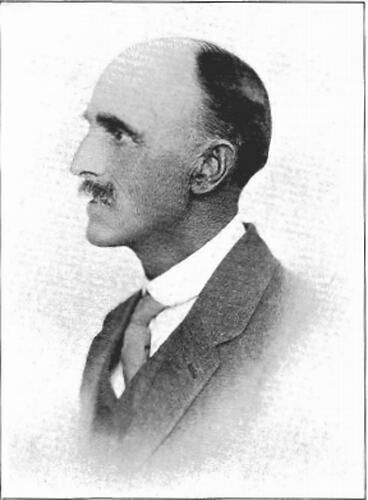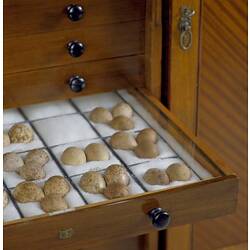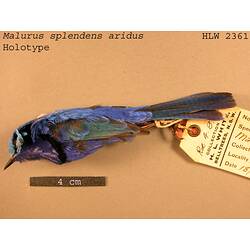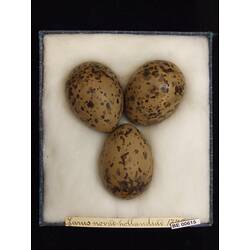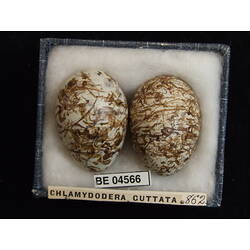Frederick Lawson Whitlock rose from the role of bank manager in Leicestershire, England, to become the most renowned bird collector in Western Australia. He was the first to obtain the nests and eggs of many Australian species and in 1901, he discovered the last 'new' bird to be discovered in Western Australia, the Grey Honeyeater, Lacustroica whitei. Whitlock's name is connected to many prominent people in the field of Ornithology, including H.L. White and G.M Matthews.
Early life
Frederick Lawson Whitlock was born 3 June 1860 in Nottingham, England. He died a widower, 15 June 1953. Not much is written about Whitlock's earlier years except that he attended Loughborough Grammar School and expressed an early interest in the natural world.
Along with his success as a bird collector what makes Whitlock an interesting character is his decision on 15 November 1879 to empty the safe of his bank and flee. Whitlock fled to Kanowna in Western Australia, a gold-digging town. A reward notice issued by Nottingham Police included a photo and the description 'he has a shifty expression when talking. He is a clever bicyclist and a collector of birds and birds' eggs, upon which he is a considerable authority. He usually converses on the subject when in company' (Shaw, 2014). Though captured and sent back to England, having served his sentence, he returned to Australia in 1901.
Interestingly, Whittell's article about Whitlock's achievements in Emu (the peer-reviewed scientific journal of the Royal Australasian Ornithologists Union) makes only vague reference to this time in his life, stating that after being an Accountant of the Leicestershire County Court he had to leave the profession for reasons of health.
Whitlock had a wife, son and daughter. He was married to Clara Ellen Neale - Whitlock in 1887 and both his wife and daughter came with him to Australia in 1901. His only son remained in England.
Collecting in Australia
Through connections with Mr L.F von Wieldt and A.W. Milligan, honorary ornithologist of the Western Australian Museum, Whitlock was given an ornithological grant to collect for the Western Australian Museum in 1902. During his appointment with the Museum, in May 1908, Whitlock also started collecting eggs for H.L. White and skins for G.M Mathews.
Some of Whitlock's notable expeditions were to the Lake Way district on the Murchison River in 1909, the Nullarbor Plain in 1921 and Central Australia in 1923. The Lake Way venture was probably Whitlock's most fruitful expedition as he collected 360 skins for Mr H.L. White's bird collection. At the Nullarbor Plain in 1921, Whitlock collected three specimens of the Blue-Bonnet Parrot, which were eventually described as a new species, Psephotus narethae.
In 1923 he experienced his most trying expedition seeking the famous Night Parrot (Pezoporus occidentalis) of Central Australia. He travelled to Henbury Station on the Finke River, which was his base for the duration of the expedition and spent up to nine months searching. In his field notes, Whitlock expressed his misgivings about the expedition. 'I confess I hesitated somewhat', Whitlock wrote, 'but I realised that, if Mr White was willing to risk the financial burden of the expedition it was 'up to me' to do my part'. Ultimately he was unsuccessful in collecting a Night Parrot skin, although his observations of the birds in Central Australia added much to Australian ornithological knowledge.
Whitlock did not stop collecting for the Museum or private collectors until White's death in May 1927.
Over the course of his career, Whitlock submitted over 50 articles to the Australian Ornithological journal, the Emu. On Whitlock's 80th birthday, Whittell wrote an article in Emu to celebrate his contribution to Australian bird-life research, referring to his writing and career as:
'Not only were Mr Whitlock's discoveries very numerous, but he has the gift of being able so to describe his field-work that the many records he left in the pages of The Emu are not only literary efforts of a high standard, but are also work-pictures of the habits of the species with which he has come into contact' (Whittell, 1940).
No one else has contributed as much to Western Australian Ornithology as Frederick Lawson Whitlock.
Related Information
H.L. White Collection of Australian Birds' Eggs
Works of the Mr Gregory Macalister Mathews Collection
References
5.000 BOOKS IN CANBERRA TELL A STORY OF AUSTRALIA'S BIRDS. (1944, February 26). The Argus (Melbourne, Vic: 1848 - 1957), p. 2 Supplement: The Argus Weekend magazine. Retrieved June 23, 2015, from http://nla.gov.au/nla.news-article11825964
Birdman At Ninety. (1950, June 10). The West Australian (Perth, WA: 1879 - 1954), p. 22. Retrieved April 28, 2015, from http://nla.gov.au/nla.news-article47868104
Encyclopaedia of Australia Science. (2010). Whitlock, Frederick Bulstrode Lawson (1860 - 1953). Retrieved from http://www.eoas.info/biogs/P000896b.htm
National Library of Australia. (n.d) Mathews Collection. Retrieved June 23, 2015, from https://www.nla.gov.au/selected-library-collections/mathews-collection
Robin, Libby. (2001). The Flight of the Emu: A Hundred Years of the Australian Ornithology. Melbourne: Melbourne University Press.
Shaw, Steven. (July, 2014). Bank manager who went from birdman to jailbird and back again! Reflections, p. 56 - 58
Whittell, M.H. (1940). Frederick Lawson Whitlock. Emu. 34: 279 -286
More Information
-
Keywords
-
Authors
-
Article types
